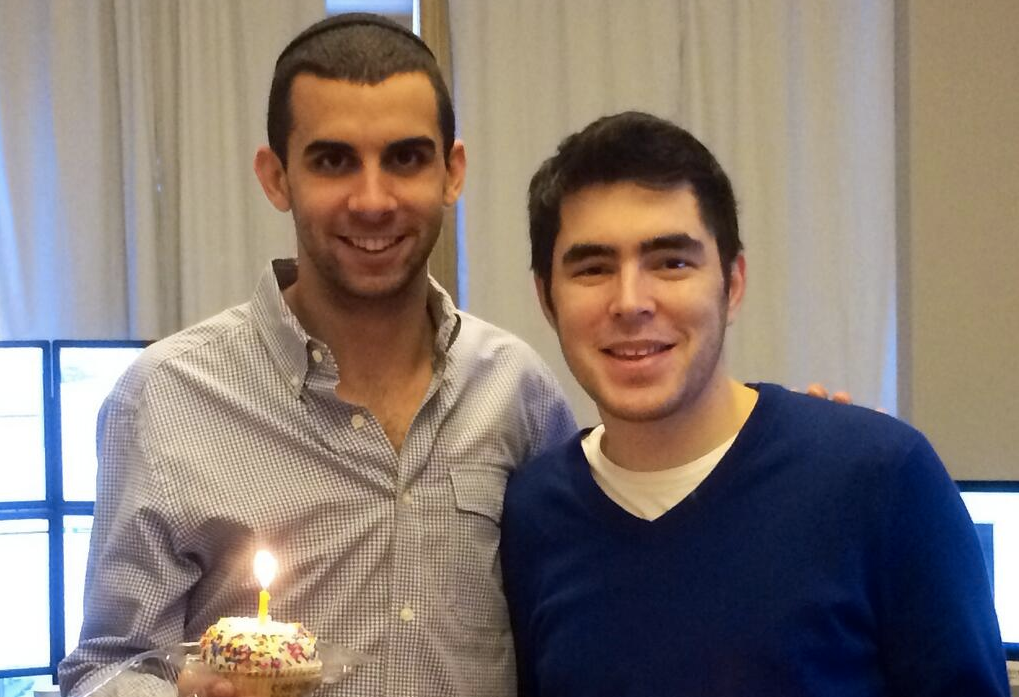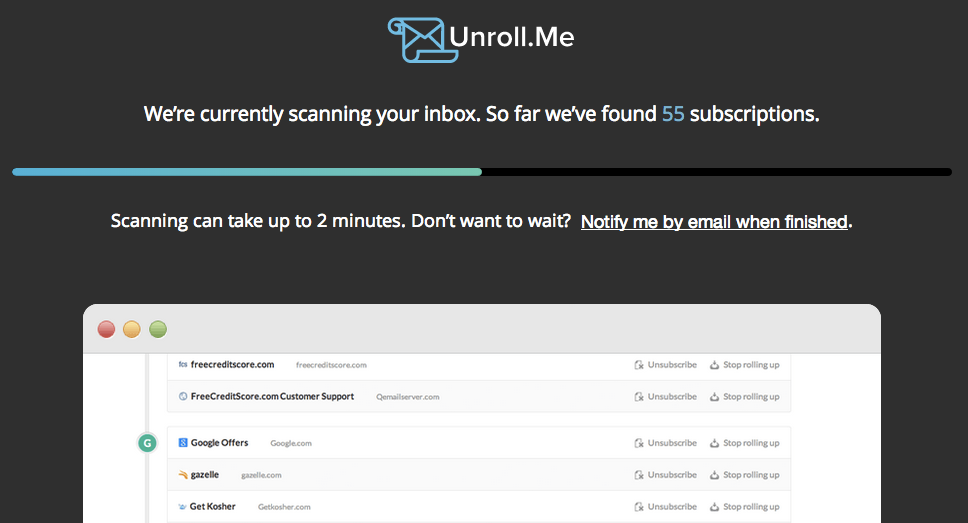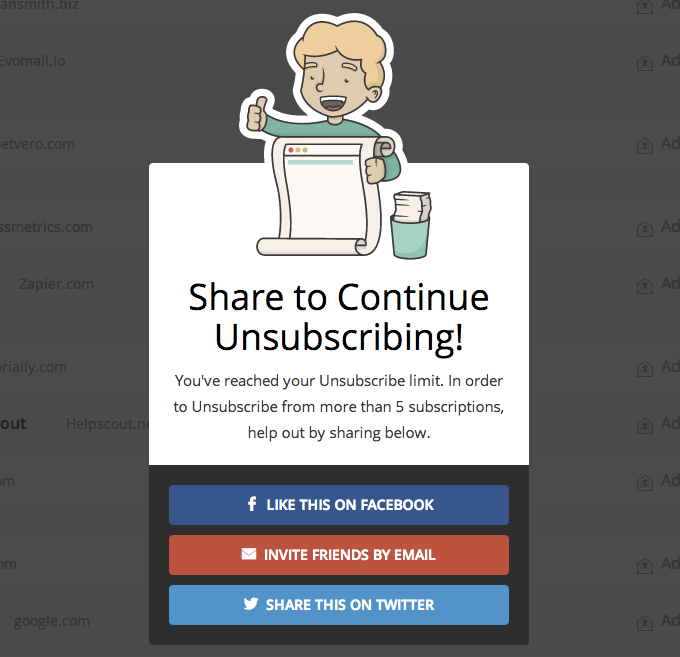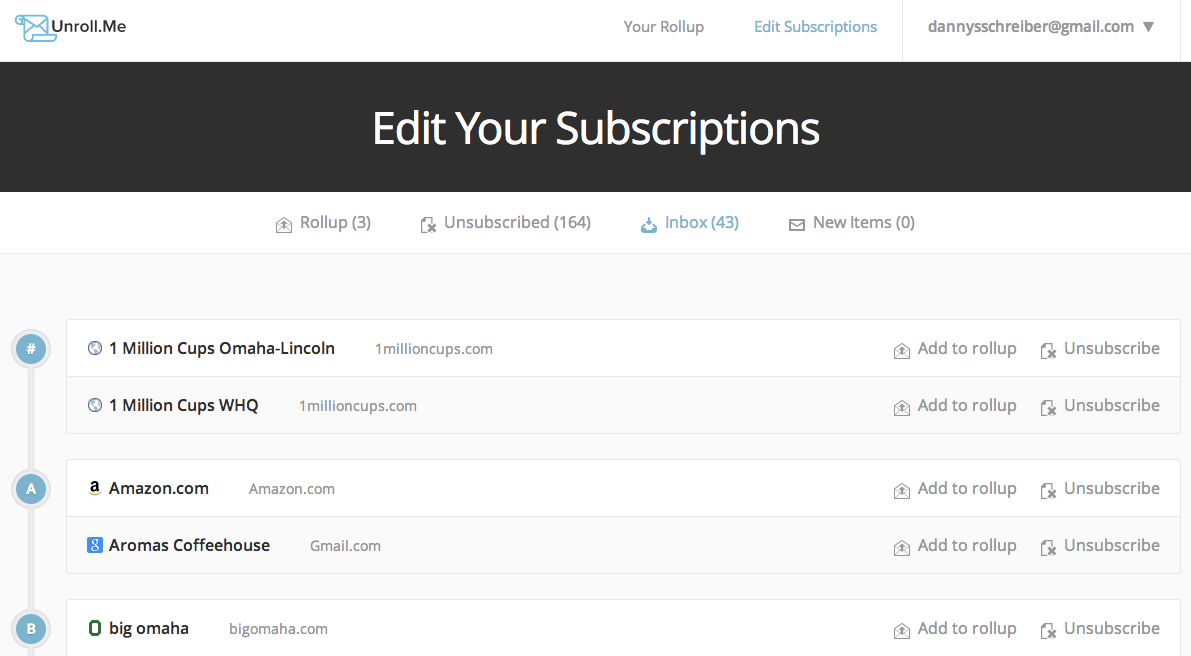With a few clicks, the ingenious Unroll.Me app gives your email inbox the spring cleaning it's needed for years. It’s free. It’s easy. It’s a godsend to email overload.
“The average consumer has well over 100 newsletters in their inbox,” says Josh Rosenwald, the startup’s CEO and co-founder. “They log in (to Unroll.Me) and they have they have this one moment in time where they see this whole list and they can manage it.”
Simple, but oh so effective. It takes less than 10 minutes to “unroll” the long list of subscriptions you’ve compiled over the years.
The service, launched by Rosenwald (below, right) and co-founder Jojo Hedaya (below, left) in November 2011, now helps more than a half-million users cut down email. The two lead a team of eight in New York, where they’ve raised a seed round to fund the company and anticipate closing a Series A round later this year.

Why a team of 10? Email isn’t an easy beast to tame. “We process probably at least tens of millions of emails per day, if not more, it’s something that is pretty difficult,” Rosenwald says.
And Unroll.Me knows they’re far from taming it. Though they don’t subscribe to the “email is broken” notion, the startup sees plenty of opportunity to revolutionize a tool that's central to one’s online activity.
Rosenwald last week spoke with me for an hour about Unroll.Me’s start, the technical hurdles his team has faced, how they use email inside the company and his personal productivity practices. And, surprisingly, he shared why he wants to be best friends—not enemies—with email marketers.
Interviewee answers edited for length.
Building Unroll.Me
Zapier: How do you describe Unroll.Me?
Josh Rosenwald: Unroll.me, as it currently stands, is an email subscription management tool. We all have too many newsletter and subscription emails in our inbox, we’re pretty overwhelmed because you get them multiple times per day from multiple different senders, and you think you clicked 'unsubscribed' only to find out you’re on 10 more email lists. We realized you need to have this one binary moment in time where you can log in with your email and password, and you can see everything you’re subscribed to. You can take control by unsubscribing, which is the very popular feature, or for emails you want to keep but don’t necessarily want in your inbox, you can add them to a daily digest.
What's the brief story behind Unroll.Me? How did it come about?
Me and my buddy were trying to start a company and we both were trying to come up with ideas. As we emailed back and forth and noticed our inboxes full of all this crap, we figured the first thing we should build was something that helped us clean out our inboxes, not intending this to be a company, just a short project to get on the same team and help people out. But it had a lot of early adoption and we decided to go with it and see what happens.
When you say 'had a lot of early adoption,' do you mean that hundreds or thousands of people signed up for it or that you received positive feedback? How did you decide to pursue Unroll.Me ?
We probably had thousands of people within the first months, maybe even more, and we also got some articles and we had some investors email us. It just seemed like we hit on a pain point for a very large amount of people. As we did research, we saw that a lot of people in this space had failed at this. There were other apps in this space at that time, as well, and it was never (an app by) a bigger, successful company. But we felt like there was enough interest and traction to give it a shot and see where it went.
In April, you rolled out your third redesign to date. What changed and how did it affect usage?
We changed a lot. The No. 1 thing was clarity for users, really explaining what we do was super important. We also changed the overall look and feel of the product, (the previous version) was a little bit darker, maybe a little more dreary—it was very tech-ish, it didn’t have a broad consumer appeal. We really want to build out a service that appeals to a lot broader demographic than just the tech community.
Growing and Scaling Unroll.Me
It seems your target audience could be quite large: anyone that uses email. How do you focus on who you want to reach and how do you reach them?
The truth is we’re not targeting at all. We’re really trying to build a system that works for everybody, and we don’t want to limit that.
The feature that pauses your use of Unroll.me until you share a link to the product via Facebook, email or Twitter is quite smart. How important has that been to growing your user base?
That’s super important. The feeling was we didn’t want to charge people for this service because it’s a huge problem for a lot of people. We really just wanted to fix it, not getting bogged down in how much do we charge and then how many people will pay for it and how do you acquire consumers. But at the same point, we are a startup and we do need to grow and this isn’t a very social product, and it’s not meant to be, it’s more of a utility. In that sense, when you have a utility that’s free and isn’t social, growth isn’t as easy to come by. So you really need to build growth into your product purposefully.

We realized that when users sign up for our service, unlike some other services, we have a lot of instant gratification. Other services, the more you put into it the more value you get out, etc. But with Unroll.Me, it’s a very instant gratification type, and so right when you sign up you achieve a high point of value, and so in exchange we’re not charging users but we decided to charge them with social capital. […] For the most part, a huge percentage do (share the app). There’s not really anybody, I’d probably say almost less than one percent, of people who leave because of that.

Unroll.me is a tool you can set and it runs smoothly in the background. With that in mind, how do you measure engagement with your app?
We have different types of users. We have users who don’t use our daily digest and the users who do use our daily digest. The one key metric I can give you is of the users who receive our daily digest, our unique open rate on a daily basis is equal to 50 percent. So half of the people who get our daily digest open it everyday.
On the technical side, it would seem there are a lot of complexities behind the scenes at Unroll.Me. What have been some of your team's biggest engineering challenges and lessons learned?
The biggest challenges have been building our email client and essentially being able to process just as many emails per user as Gmail does, which is super difficult to do in real-time. […] Then scaling that pretty quickly—we process probably at least tens of millions of emails per day, if not more. That’s the biggest challenge we’ve had.
There’s a lot of smaller challenges, like how you process specific emails, how you identify what a newsletter or subscription email is, building a categorization engine to figure out what newsletters are—are they daily deals or retail offers or sports newsletters? That’s another big challenge.
Overall, the inbox and email present just a ton of challenges of playing in other people’s backyards, like all these ISPs (Internet service providers), Gmail, Yahoo, AOL, Hotmail/Outlook, Apple Mail, so it definitely presents its challenges. But so far, as a team, we’ve been able to overcome every single one.
Keeping Unroll.Me Simple
You talk about the technical difficulties of Unroll.me, but overall the app offers a simple experience for a user. How have you decided what feature to make part of the app? Like why can't a user create a second daily digest?
It’s always been about simplicity. We tried to build a simple, elegant solution to a very large problem. When you take on legacy players in the space, like a Gmail or Yahoo—I mean, we don’t see ourselves as competition as much as working within their ecosystems—but when you want to offer a tool in email, your offer needs to be something of extreme value because getting people to change habits is really, really difficult. Then getting people to change habits when there’s a bunch of really large players in the space is even more difficult.

Our feeling was, 'Hey, let’s build a real simple, elegant solution that regardless of the demographic or computer illiteracy, a person can engage with this.’ So that’s been our guiding philosophy to now. Things like specific features, like adding (daily digests), those will come. There’s a bunch of obvious things we’d like to add and things we’d like to do. We’re working on something pretty big right now that we think is really going to help redefine the shape and the scope of email. A lot of what we’ve been saving up for, as opposed to letting it slowly trickle out, is one really big push.
In Unroll.me's FAQ users can discover a feature that allows them to block contacts in their email. What other features might users be missing out on when using Unroll.Me?
Our two best secrets are, well, it’s one secret that does two things, is our 'forward it.' Right from your inbox, if you want to add something to your (daily digest), you just forward that email to rollup@unroll.me, and if you want to unsubscribe from anything, you just forward it, whether you’re on your mobile or desktop, to unsubscribe@unroll.me. You don’t need to come back to our site, it will do it right from your inbox.
Figuring Out the Future of Unroll.me
You have the restrain not to call Unroll.Me a new email client, instead you call it an add-on to something people are already comfortable with. Why this restrain?
Our understanding has always been this: email is something very sacred to everybody and very sensitive to everybody, and in order to get somebody to change an email client, you can’t just be 10 or 20 percent better. In the rest of business, if something is 10 or 20 percent cheaper or does 10 or 20 percent more work, more efficiently, people switch to that, that’s a no brainer. It’s a 20 percent increase in whatever. But when it’s things like your email client, if something is just 10 or 20 percent better, you’re not going to switch. […] So we don’t want to take (Gmail, Yahoo and the others) on and we don’t want to build something that we don’t think consumers are asking for. I don’t think consumers are saying, 'Hey, we need new email clients.' I think consumers are saying, 'Hey, we need to make email work.' We have this grand vision and Unroll.Me is just a small first step in that.
You've talked about selling advertising in Unroll.me's daily digest emails for future revenue. Have there been trials of this advertising yet?
We’ve dabbled with advertising in our daily digest, it’s been something that’s interesting. We really spent the last year in an exploratory phase in terms of different models and future revenue and we’ve gotten a lot of clarity. We kind of understand the business side of our product, and how we’re going to monetize and now that we have that and we’re able to share that with investors and get some excitement around it. It’s become a lot easier to come back over and say, 'Hey, now here’s our product vision.'
Originally, when we had some cool product vision, a big reservation for investors was, 'Yeah, it’s all great and yeah I’m sure that would work, but if you can’t figure out a way to make money, you’re banking on Gmail or Yahoo buying you, which is not to say the soundest investment.'
Now, people can understand how and when we can be a really large and profitable company on its own and doesn’t need to be acquired by anybody. So that allows us a lot more leeway and freedom within product exploration and innovation.
In one news article you hinted at future productivity products to come from Unroll.Me. Is that still part of your team's vision?
Yes. We’re working on something right now that we really think will change in a large way the landscape of email. It’s going to be a bunch of months between closing funding and raising capital and expanding the team, hopefully, while we build out our next product or our next version of the product, etc. I don’t want to give a timeframe I can’t stick to, but certainly at some point in 2014, we’re going to do something that we think will revolutionize email.
How does email play into Unroll.me's company operations? Is email important to the Unroll.me team itself?
It’s super important to us. We all play around in email all day, and that’s probably our No. 1 productivity tool as ironic as that is because email is usually considered one of the least productive things to do. That really is actually a benefit to ourselves and, eventually, hopefully our users by us asking the question everyday, 'How are we going to be more productive in our email inbox?' Not saying, 'Hey, let’s jump to another productivity tool because email is broken.' Because then we’re cannibalizing ourselves, saying, 'Hey, well, if we can’t stick with email, why should anyone else?' […] Whatever it does cost us in productivity, it definitely benefits us in innovation.
Email Marketing and Unroll.Me
Has Unroll.me ever considered a newsletter itself? Does Unroll.Me use email marketing?
It’s a very sensitive topic because our user’s view, rightfully so, is, 'Hey, you’re here to clean up my inbox why are you sending me stuff?' So we’re really sensitive on how we do it. Once in a very long while, we do need to communicate with our users some how. But I would say, if we hadn’t built the product we built and if we were from another company, we’d be sending out a lot more email than we do just because it is such a good engagement tool.
What can Unroll.Me teach marketers?
There’s a lot we can teach marketers and that’s super helpful in terms of future business models. I personally think email is great for marketers, but I also think it’s really good for consumers. […] So we’re definitely not trying to kill it or hurt it. […] What we’re saying is, first, let’s level the playing, where yes, you can send something but a consumer can also say, 'I don’t want it,' and can easily manage that. What we’ve seen is giving power back to a user, and power not only in, 'Hey, what do I want to get but when do I want to get it.' Sure, Banana Republic, I did sign-up for your email, but I didn’t sign-up to get it at 8 a.m. when I’m trying to do work or at 4 in the afternoon. I think we’re among competing interests because I would love to get the offers I want when I’m not busy and when I can have time to look at them. A company sending me an offer would like to send it to me when I’m busy because they know that’s when I’m looking at email and that’s when I’m going to look at that their offer. […]
We think there’s this really good middle ground of, yes, consumers want offers and that’s why email marketing does drive tons of sales. But we think if you can give them better offers, more targeted offers at the right time, that benefits consumers because there’s less noise and a lot more of what they want and marketers because they can spend less money reaching people who are just not interested and they can spend more money to drive more sales from the people who are interested in their product.
When do the most people prefer to receive Unroll.Me? Morning, afternoon or evening?
The original testing we’ve done shows that most of our users were using it in the morning, but that might be skewed because I can’t tell you what percentage of users are too lazy or don’t care enough to switch it away from morning (default setting) or don’t realize they can. It’s probably the most liked but I can’t tell you why or the motivation behind it.

In the life of Josh Rosenwald, what's worse: Opening up an inbox to a 100 marketing emails or walking into a room with a 100 email marketers?
Opening up an email inbox with 100 marketing emails is a lot scarier—it’s definitely less scary with Unroll.Me (because) I can unsubscribe. But if I walk into a room with 100 email marketers, those are 100 potential future customers and clients, that’d be like a nice big dream for me.
So they wouldn't have angst against Unroll.Me? They have potential to be best friends with Unroll.Me?
They definitely have angst now, right? What’s the opposite of love? It’s hate. If I find these people who just don’t care about my product, then that’s going to be pretty difficult to engage with them, let alone convince them to use whatever service we have. Email marketers know who we are, fortunately for us, and they might hate us right now, but that’s just a misconception or misperception of who we are and what we do. And I think when we’re ready to release our business model and start engaging with them, I think they’ll quickly see the benefits of working with us. There’s probably some angst already right now but I think we’ll be able to turn that around, which is pretty exciting for me.
Putting Productivity in Josh's Schedule
In your own routines, outside of using Unroll.Me, where else are you putting efficiency into your processes?
There’s two things: one is scheduling and the other one is investing my personal resource of time. When it comes to scheduling, figuring out when I have to set up calls, every time I knock out a bunch of those—so this is like my fourth call in a row—because you don’t want to be in a meeting to have to run to a call and then run to the next meeting. I think scheduling has been something that’s been super important. There are some good apps out there, none that I used that worked really well for me. I wish there was something that was a Mint.com for scheduling, it didn’t just let me schedule but suggested, 'Hey, break up your time this way, or hey, you’re more efficient when you do things that way.'
In terms of time management, early on I chased down a lot of partnership opportunities and a lot of other type of opportunities and a lot more networking, and I realized the only thing you have finite or limited in the world is time. […] A big thing that I’ve worked on to increase my efficiency as well as the efficiency of my company is (knowing) what time-based investments you need to make and when you need to make them and when to pull the plug and when to say, 'Hey, that sounds great but it’s just not the right time for us.' When you think something is an opportunity, that’s always the hardest thing to walk away from.
Final Word
What else would you like to share about Unroll.Me?
Our understanding has been email is not broken, it’s got a lot of issues. We’d love for people to share with us—my email is josh@unroll.me—not only specific product improvements or new features, which we really like to hear from our customers or potential customers, but also things with email that they think are broken that should be fixed.
Credits: Images courtesy Unroll.Me
You might also like this interview: From 0 to 100,000 Users in 4 Months: The Story Behind Productivity Chrome Extension Momentum





